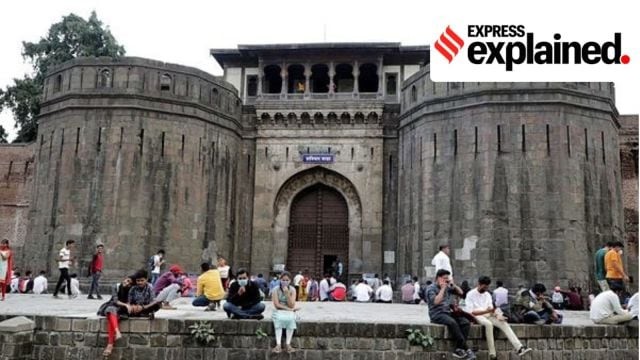



Shaniwar Wada in Pune was the grand residence of the Peshwas, the Prime Ministers of the Maratha Empire. Built in 1730 by Baji Rao I, it served as a center of administration, military strategy, and cultural life. The fort is known for its impressive architecture, including court halls, mirror halls, and fountains. Mastani, Baji Rao’s consort, also resided here, reflecting the era’s cultural tolerance. Though largely destroyed by fire in 1827, its ruins and gates remain an important symbol of Maratha history and heritage.

Copyright infringement not intended
Picture Courtesy: Indian Express
Shaniwar Wada, located in Pune, was the grand residence of the Peshwas, the powerful Prime Ministers of the Maratha Empire. Among its notable residents was Mastani, the Muslim princess and consort of Peshwa Baji Rao I.
The foundation stone of Shaniwar Wada was laid on January 10, 1730, a Saturday, which gave the mansion its name. The construction took two years and cost Rs 16,110. The mansion included:
Shaniwar Wada was designed to serve both residential and administrative needs, with expansions made over time as the family and administration grew.
The Maratha Empire was established with Chhatrapati Shivaji Maharaj’s coronation in 1674. By the 18th century, it dominated large parts of India.
Baji Rao relocated the family residence from Saswad to Pune, establishing Shaniwar Wada as the Peshwa’s new home.
Shaniwar Wada stands as a symbol of Maratha power, architectural brilliance, and cultural diversity. Though largely in ruins today, it reflects the grandeur of the Peshwas’ era, their administrative prowess, and their tolerance towards different communities. The site continues to attract visitors, offering a glimpse into India’s rich historical and cultural heritage.
Source: Indian Express
|
Practice Question Q. Discuss the historical and cultural significance of Shaniwar Wada in Pune. Highlight its role during the Peshwa era, architectural features, and its reflection of religious tolerance. (250 words) |
Shaniwar Wada is a historic fortification in Pune that served as the residence of the Peshwas, the Prime Ministers of the Maratha Empire.
It was built by Peshwa Baji Rao I, with the foundation stone laid on January 10, 1730.
It was the administrative and residential center of the Peshwas, reflecting Maratha political power, architectural grandeur, and cultural tolerance.


© 2025 iasgyan. All right reserved